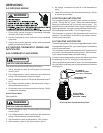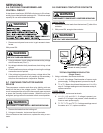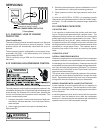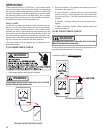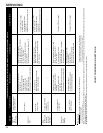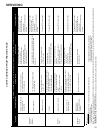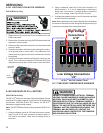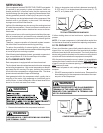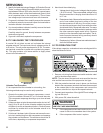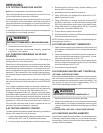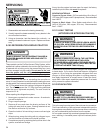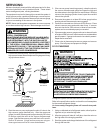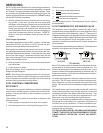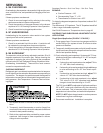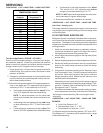
SERVICING
31
If the compressor terminal PROTECTIVE COVER and gasket
(if required) is not properly in place and secured, there is a
remote possibility if a terminal vents, that the vaporous and
liquid discharge can be ignited, spouting flames several feet,
causing potentially severe or fatal injury to anyone in its path.
This discharge can be ignited external to the compressor if the
terminal cover is not properly in place and if the discharge
impinges on a sufficient heat source.
Ignition of the discharge can also occur at the venting terminal
or inside the compressor, if there is sufficient contaminant air
present in the system and an electrical arc occurs as the ter-
minal vents.
Ignition cannot occur at the venting terminal without the pres-
ence of contaminant air, and cannot occur externally from the
venting terminal without the presence of an external ignition
source.
Therefore, proper evacuation of a hermetic system is essen-
tial at the time of manufacture and during servicing.
To reduce the possibility of external ignition, all open flame,
electrical power, and other heat sources should be extinguished
or turned off prior to servicing a system.
If the following test indicates shorted, grounded or open wind-
ings, see procedure S-19 for the next steps to be taken.
S-17A RESISTANCE TEST
Each compressor is equipped with an internal overload.
The line break internal overload senses both motor amperage
and winding temperature. High motor temperature or amper-
age heats the disc causing it to open, breaking the common
circuit within the compressor on single phase units. The three
phase internal overload will open all three legs.
Heat generated within the compressor shell, usually due to
recycling of the motor, high amperage or insufficient gas to
cool the motor, is slow to dissipate, allow at least three to four
hours for it to cool and reset, then retest.
WARNING
1. Remove the leads from the compressor terminals.
WARNING
SEE WARNINGS S-17 BEFORE REMOVING COMPRES-
SOR TERMINAL COVER.
2. Using an ohmmeter, test continuity between terminals S-
R, C-R, and C-S, on single phase units or terminals T1, T2
and T3, on 3 phase units.
S
R
C
COMP
OHMMETER
TESTING COMPRESSOR WINDINGS
If either winding does not test continuous, replace the com-
pressor.
NOTE: If an open compressor is indicated allow ample time
for the internal overload to reset before replacing compressor.
S-17B GROUND TEST
If fuse, circuit breaker, ground fault protective device, etc., has
tripped, this is a strong indication that an electrical problem
exists and must be found and corrected. The circuit protective
device rating must be checked and its maximum rating should
coincide with that marked on the equipment nameplate.
With the terminal protective cover in place, it is acceptable to
replace the fuse or reset the circuit breaker ONE TIME ONLY
to see if it was just a nuisance opening. If it opens again, DO
NOT continue to reset.
Disconnect all power to unit, making sure that all power legs
are open.
1. DO NOT remove protective terminal cover. Disconnect the
three leads going to the compressor terminals at the near-
est point to the compressor.
WARNING
DAMAGE CAN OCCUR TO THE GLASS EMBEDDED
TERMINALS IF THE LEADS ARE NOT PROPERLY
REMOVED. THIS CAN RESULT IN TERMINAL AND
HOT OIL DISCHARGING.
HI-POT
COMPRESSOR GROUND TEST



